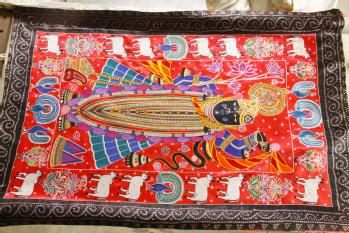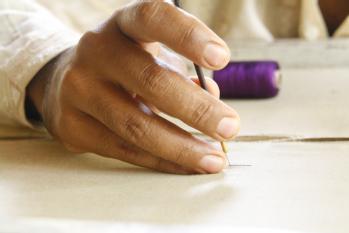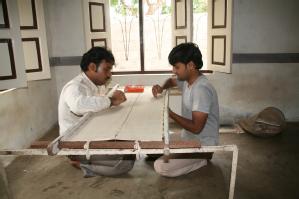Kasam and Juma Sangar
|
Age: 26 and 22 Education: Class 5 and Class 3 Residence: Mandvi, originally from Bhuj. |
Gujarati Summary: Download |
|
Interview Summary
Kasam and Juma have worked with mochi aari embroidery since their teens. Their father, who died of heart disease three years ago, was a master craftsman and he taught his family the art of chain stitching. Their mother and sister also follow the Mochi embroidery on mashru. Kasam’s great grandfather who worked as zari worker in Mumbai first followed the mochi work. Their grandfather was a taxi driver and therefore their father learnt mochi work from their great-grandfather. Although they have followed this craft for many generations, they are not from the Mochi community but from the Sangar community. The traditional art form they follow has also undergone many changes. Originally, Mochi embroidery was practiced without a frame. The Sangar brothers however use an adjustable frame known as samsheer to tuck up the cloth over which another cloth (preferably Mashru) is roughly stitched. Another change is that in traditional mochi work a hook is used similar to a cobbler’s awl, called aari, that has a wooden handle. These brothers instead use a thick needle-like hook without a wooden handle with different sized holes. Mochi embroidery is remarkably a slow process and if followed with a needle it becomes even slower. This often causes difficulties for the Sangar family as they can rarely meet bulk orders and therefore cannot link up with wholesalers. Another drawback is that like other crafts they cannot easily make a sufficient volume of work to send an entry for the state and national awards. To compound this, during the last two to three seasons they have barely generated any sales. This has forced them to labour in the shipyards of Mandvi, earning them 150 to 200 rupees a day. Such a story does not bode well for the future of the intricate art of mochi embroidery, which was already seen as a dying art in the 1950s and 1960s.
 Kasam, who explained the process, says that first stage involves a stencil of the designs on butter paper, on which the outline of the design is needled. Mashru, which is a mix of silk, satin and cloth, is preferably used as the base cloth to get an elegant look for the finished product. A fine black powder colour is sprinkled which slips through the holes in the tracing paper over the cloth and imprints the design. The designed cloth is tucked over the samsheer and by keeping the left hand beneath and the right hand above the cloth, the thread is pierced with the needle to embellish a fine chain-stitched embroidery.2 For the powder colours, kerosene and natural colour obtained from black stone are mixed. The other raw materials such as mashru, thread, tracing paper, and the iron for the hook, are all obtained from either the market of Bhuj or Mandvi. In creating the mochi embroidery their key instrument undoubtedly is the hooked needle. Not only is making the hook difficult as it takes two days’ time to cut the iron and shape it to convert it into as a rounded thin rod, but keeping it rust free is also vital. To keep the needle rust free they use a holder greased with wax. To get the desired shape it is intensively worked with the help of a tool call kanas. This is quite laborious process and the needle must be handled carefully to avoid injury.
Kasam, who explained the process, says that first stage involves a stencil of the designs on butter paper, on which the outline of the design is needled. Mashru, which is a mix of silk, satin and cloth, is preferably used as the base cloth to get an elegant look for the finished product. A fine black powder colour is sprinkled which slips through the holes in the tracing paper over the cloth and imprints the design. The designed cloth is tucked over the samsheer and by keeping the left hand beneath and the right hand above the cloth, the thread is pierced with the needle to embellish a fine chain-stitched embroidery.2 For the powder colours, kerosene and natural colour obtained from black stone are mixed. The other raw materials such as mashru, thread, tracing paper, and the iron for the hook, are all obtained from either the market of Bhuj or Mandvi. In creating the mochi embroidery their key instrument undoubtedly is the hooked needle. Not only is making the hook difficult as it takes two days’ time to cut the iron and shape it to convert it into as a rounded thin rod, but keeping it rust free is also vital. To keep the needle rust free they use a holder greased with wax. To get the desired shape it is intensively worked with the help of a tool call kanas. This is quite laborious process and the needle must be handled carefully to avoid injury.
Though their work has met international standards for the last three years, their enthusiasm for their trade was dampened because of their father’s death. They are not taking a keen interest in participating in the exhibition to generate more sales, or in changing their marketing strategies, and introducing customisation. Sporadic orders from abroad through email generate most of their sales. The clients that they do have come from all over the world however, including Australia, England, Japan, Ahmedabad, Delhi and Mumbai. Even the famous Calico Museum has put their work on display.
They take five to six months to complete a large piece of work that will command a high price. In their work, motifs represent stories, messages or events. Scenery and landscapes are also interwoven in the work which often depicts rain, farms and characters from daily life. In one of their pieces of work, Jesus Christ is shown surrounded by men and women of various religious communities. The rural landscape in the background is embroidered in such a way as to depict the age of Christ where he preaches to the commoners to abide by the truth and be virtuous through doing good work. One of their most intriguing works depicts the landscape of Kachchh following the 2001 earthquake. Australian designer Carol Douglas encouraged these types of designs, through a project which worked with many Kachchhi artisans to encourage them to express their emotions through their respective art forms. Although they are Muslims, the Sangars also do not deter from creating the images of Hindu religious God such as Lord Shrinathji. For Kasam, this work is very close to his heart as he had devoted seven months of time to it. These artists deserve praise for promoting communal harmony through their work and attempting to spread a message of peaceful coexistence and of the amalgamation of cultures.
 Their family history is marked by migration. Originally from the Abdasa region of Kachchh, the Sangar family come from the village of Bhudiya near Naliya Taluka. There they were labourers and did not work as artisans. Once they migrated from Bhuj, they began Mochi embroidery work but without much success, forcing them to also pursue masonry work to make ends meet. When Adham Sangar moved to Mumbai to work as a zari worker, the family’s fortunes changed. There he developed his skills in fine mochi work. After living in Bhuj for many years, the family migrated once again to Mandvi following the earthquake.
Their family history is marked by migration. Originally from the Abdasa region of Kachchh, the Sangar family come from the village of Bhudiya near Naliya Taluka. There they were labourers and did not work as artisans. Once they migrated from Bhuj, they began Mochi embroidery work but without much success, forcing them to also pursue masonry work to make ends meet. When Adham Sangar moved to Mumbai to work as a zari worker, the family’s fortunes changed. There he developed his skills in fine mochi work. After living in Bhuj for many years, the family migrated once again to Mandvi following the earthquake.
Their mother, Hazarabai Adham (45), also helps in the craft although she has no formal education. Hazrabai has done embroidery for many years and she still works whenever she is free from her household tasks. In common with many of the women of Kachchh who work in embroidery or bandhani, she never sits without work. The combined efforts of whole family produce one or two pieces of mochi aari in a day, and a whole design is completed in four to five days. Although many people can work on a single piece, each of their stitches are almost identical. The motifs and designs they produced vary, but it seems the peacock is their favourite.
Although their work is in high demand, there is little consistency. They are extremely proud of their work and caution buyers that they should only purchase if familiar with the history, intricacy and value of the craft. Kasam felt strongly that since this art is not performed by many, it should be given a more honourable standing. He also added that despite the fact the family taught several others the craft, in general very few have shown an interest. Kasam believes that the reason for that is that the work requires a lot of patience and sitting in one place, almost imprisoning a person. The art also needs several years’ apprenticeship to produce work of a high standard, and the high costs involved in training under modern conditions, do not encourage optimism. Despite this, the brothers have recently trained a small group of women and men.
The Sangar family usually works from 7 am to 7 pm (with lunch breaks), stopping when dusk falls. Around this time they often feel a blurry sensation in the eyes for around three to four minutes and often suffer from double vision because of the strain the work places on the he eyes.
For the Mochi designs, like weavers and other embroiderers, they have developed a specific vocabulary to identify the various types of designs such as piyala, sankadi trikhonia. Local demand is practically non-existent, perhaps due to the intricate nature of mochi that places it out of the price range of many local inhabitants. Just a small piece of work is 200 Rupees at a minimum. Their work is washable though, and the colour in both the cloth and the thread does not run.
Tourism, through the ‘desert festival’ has not helped the family. Many tourists attend the festivity but leave before reaching the port town of Mandvi, many miles away from the desert. The family needs both encouragement and exposure to further their business.
___________________________________________________________________________________________________________________________________
1 Kachchh was known for its embroidery since at least since medieval times. The records of the English East India Company show that from the earliest days of their trade in India, they were keen to acquire these already-renowned embroideries. Specific instructions were given to the merchants to buy quilts made around Cambay, and from 1614 onwards they feature in the Company’s London auction sales. The export of chain stitch embroideries to Europe declined in the eighteenth century, but a vigorous local tradition of professional embroidery persisted in Bhuj until modern times under the patronage of the local court and nobility. These embroiderers were all members of the Mochi or leather working caste and according to verbal tradition,their forefathers had originally emigrated to Kutch from Sindh, bringing their embroidery skills with them. Mochi embroidery was part of a way of life that has all but vanished however, and is not likely to be revived in light of the social and economic pressures shaping India today. (Notes on the use of the Hook in Indian Embroidery by John Irwin and Babette Hanish c.1957 pp.1-13)
2 The needle is held in the right hand and the hook, pointed away from the embroiderer, penetrates the cloth to pick up the thread fed by the left hand from beneath the fabric. The loop is then brought to the surface by withdrawing and quarter-turning the ariaway from the embroiderer. No knots are made at the beginning or end of the work. Each successive loop is created in the same way except that after the first loop is made, the aripasses through its centre to pick up the next one, thereby creating a chain unlike that obtained in tambour embroidery or crocheting. The ariis limited by the fact that it can only produce loops, but this limitation is, in another way, its virtue since it permits a person competent in the use of this awl-like implement to work more quickly than would be possible with a needle. The pattern is worked out on the upper surface of the cloth with chain-stitch used both for filling in and outlining the motif. Only a colour change distinguishes between the two. Each stitch requires only one puncture of the cloth by the arito create a loop, compared with a needle which requires a double action to make a loop and usually results in two piercings per stitch. The single puncture for each aristitch means that a continuous thread can run from hole to hole with no gaps between. Unlike the needle which can, and often does, pick up only the surface of the fabric leaving bare spots beneath, the ari must penetrate the cloth completely to pick up the thread below, producing a stitch on the reverse side for each one above. (Notes on the use of the Hook in Indian Embroidery by John Irwin and Babette Hanish c.1957 pp.1-13).

